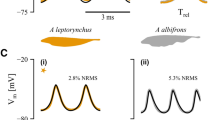Abstract
The spontaneous and light-evoked firing patterns of the compound action potentials (CAPs) in the isolated eye of Aplysia are experimentally observed from a control systems viewpoint. The eye, exhibiting an endogenous bursting activity and a marked circadian rhythm in darkness, is a self-excited system and responds to illumination with a controlled electrical activity. It is represented by the nonlinear systems model predicting the firing-rate variation of the CAPs. Construction of the model is based on the eye's biological model reported in the literature, and involves an experimental analysis of the system characteristics using linear approximation and conventional control systems techniques. The model is simulated and found to adequately conform to the observed behavior of the eye under various experimental conditions.
Similar content being viewed by others
References
Aschoff, J.: Exogenous and endogenous components in circadian rhythms. Cold Spr. Harb. Symp. quant. Biol. 25, 11–28 (1960)
Aschoff, J.: Response curves in circadian periodicity. In: Aschoff, J. (Ed.): Circadian clocks, pp. 95–111. Amsterdam: North-Holland 1965
Audesirk, G.: Neuronal interactions in optic nerve impulse production in Aplysia. Physiologist 14, 105 (1971)
Audesirk, G.: Spontaneous and light-induced compound action potentials in the isolated eye of Aplysia: Initiation and synchronization. Brain Res. 59, 229–242 (1973)
Austin, G., Yai, H., Sato, M.: Calcium ion effects on Aplysia membrane potentials. In: Wiersma, C.A.G. (Ed.): Invertebrate nervous system, pp. 39–53. Chicago: University of Chicago Press 1967
D'Azzo, J.J., Houpis, C.H.: Frequency response. In: Feedback control system analysis and synthesis, pp. 278–322. New York: McGraw-Hill 1966
Eskin, A.: Properties of Aplysia visual system: In vitro entrainment of the circadian rhythm and centrifugal regulation of the eye. Z. vergl. Physiol. 224, 421–440 (1971)
Eskin, A.: Phase shifting a circadian rhythm in the eye of Aplysia by high potassium pulses. J. comp. Physiol 80, 353–376 (1972)
Graham, D., McRuer, D.: Mathematical theorems on limit cycles. In: Analysis of nonlinear control systems, pp. 345–353. London-New York: J. Wiley 1961
Jacklet, J.W.: Electrophysiological organization of the eye of Aplysia. J. gen. Physiol. 53, 21–42 (1969a)
Jacklet, J.W.: A circadian rhythm of optic nerve impulses recorded in darkness from the isolated eye of Aplysia. Science 164, 562–564 (1969b)
Jacklet, J.W.: Circadian locomotor activity in Aplysia. J. comp. Physiol. 79, 325–341 (1972)
Jacklet, J.W., Alvarez, R., Bernstein, B.: Ultrastructure of the eye of Aplysia. J. ultrastr. Res. 38, 246–261 (1972)
Jacklet, J.W., Geronimo, J.: Circadian rhythm: Population of interacting neurons. Science 174, 299–302 (1971)
Milsum, J.H.: Higher order, nonlinear, and spatially distributed models. In: Biological control systems analysis, pp. 209–239. New York: McGraw-Hill 1966
Minorsky, N.: Energy fluctuations in a Van der Pol oscillator. In: Nonlinear oscillations, pp. 219–224. Princeton: Van Nostrand 1962
Sener, R.: Site of circadian rhythm production in Aplysia eye. Physiologist 15, 262 (1972)
Stark, L.: Stability, oscillation, and noise in the human pupil servomechanism. Proc. Inst. Radio Engrs. 47, 1925–1939 (1959)
Stark, L.: Functional analysis of pupil nonlinearities. In: Neurological control systems studies in bioengineering, pp. 160–183. New York: Plenum Press 1968
Stark, L., Hermann, H.T.: Light transfer function of a biological photoreceptor organ. Kybernetik 1, 124–129 (1961)
Strumwasser, F.: The cellular basis of behavior in Aplysia. J. Psychiat. Res. 8, 237–257 (1971)
Strumwasser, F.: Neural and humoral factors in the temporal organization of behavior. Physiologist 16, 9–42 (1973)
Waser, P. M.: The spectral sensitivity of the eye of Aplysia californica. Comp. Biochem. Physiol. 27, 339–347 (1968)
Wever, R.: A mathematical model for circadian rhythms. In: Aschoff, J. (Ed.): Circadian clocks, pp. 47–63. Amsterdam: North-Holland 1965
Author information
Authors and Affiliations
Rights and permissions
About this article
Cite this article
Kim, Y.I., Kim, M. Control systems model of the spontaneous and light-evoked patterns of the compound action potentials in the eye of Aplysia . Biol. Cybernetics 23, 203–209 (1976). https://doi.org/10.1007/BF00340336
Received:
Issue Date:
DOI: https://doi.org/10.1007/BF00340336



